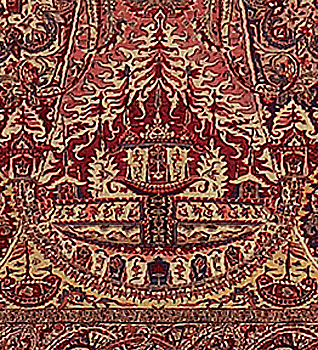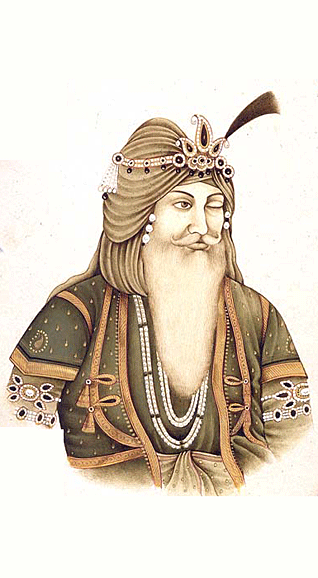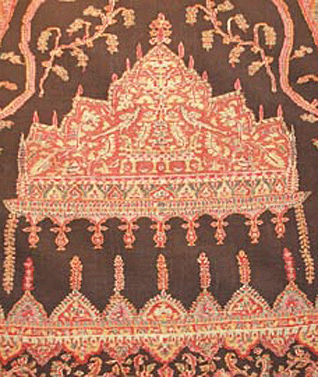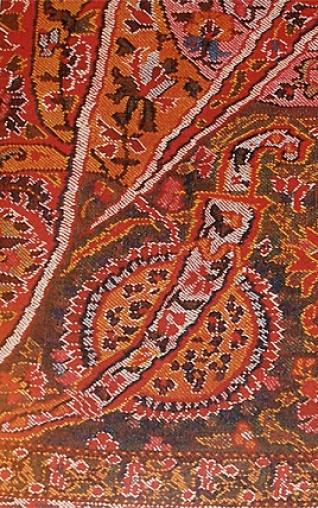
Photos of details from antique shawls on this page: courtesy, Frank Ames. Above: Shawl showing a boat pattern based on Maharaja Ranjit Singh's funeral bier. 1st from bottom: Shawl depicting a kirpan. 2nd from bottom: Shawl depicting the Akal Takht.



Columnists
Woven Masterpieces of Sikh Heritage
by NEHA SINGH GOHIL
Maharaja Ranjit Singh's death, like his life, was a grand affair.
Thousands of people thronged the funeral procession of the great Emperor of Punjab, throwing flowers over the body. Dozens of learned priests of all faiths and denominations offered prayers for his soul. Some of his many queens and their attendants, bedecked in jewels, joined the procession, a few intent on performing sati, even over the protestations of the Sikh clergy.
And in the midst of it all, the Maharaja's funeral bier was raised high by hundreds of men. Shaped like a giant boat with sails of silk and brocade, the pricey sandalwood bier was the tool entrusted with carrying the Maharaja's soul to its final destination.
This ostentatious display left its mark in more than just history books.
It wove itself, quite literally, into the fabric of that time - shawls, to be exact. Historians of the Kashmiri Shawl have found depictions of Maharaja Ranjit Singh's funeral bier on antique shawls dating to the mid-19th century. The palla of one crimson shawl shows the boat-shaped bier surrounded by saffron flames. Another puts the boat atop colorful, dancing waves of buti (paisleys).
The art of the Kashmir shawl, which reached new heights under the patronage of Ranjit Singh, always involved more than just fancy cloth.
From the times of the Mughals, Kashmir's shawls had been absorbing elements of the world around them into their patterns. Weavers took inspiration from Persian artists, European botanists, and even the Chinese alphabet. The Mughals preferred floral designs, with droopy stems and colorful petals. Persians introduced Quranic art as a design element.
"Kashmir's shawls should be seen as a visual allegory of the social consciousness that percolated in that area at the time", says Frank Ames, a renowned art historian who specializes in textiles. The shawls, like Kashmir itself, represent a crossroads of cultures.
When the Sikhs rose to power in Kashmir, Maharaja Ranjit Singh's love of art and of having his courtiers dressed up to the nines made the shawls a staple of the court. One Russian visitor described the scene this way: "the tents were doubled with Kashmir shawls ... we only walked on Kashmir shawls and while sitting down, I perceived that all the alleys, ceilings and streets - as far as the eye could encompass - were covered thusly of superb shawls; even the horses were prancing on them".
Shawls were commissioned by the thousands, and the patterns changed to resemble the times.
Maharaja Ranjit Singh's penchant for art and architecture took hold in the textiles. The outlined domes of gurdwaras slowly became an established design element in these shawls. Some even resembled the Akal Takht building in Amritsar. Instead of spaced-out garden designs along the border, the shawls from the Sikh period had multi-colored, layered patterns, filling the shawl to the center.
And the Sikhs' martial culture, the force behind Ranjit Singh's empire, was also reflected in everyday wear. Kirpans and shields are clearly visible in some antique shawls. So are the crescents and stars inspired by Akali turban ornaments (known as quoits).
Celebrations of Ranjit Singh's conquests nearly always involved dazzling firework displays, which were mirrored in what Ames calls "pyrotechnic shawls". In these, a flamboyant parade of colors, like fireworks, was woven into warm wool and pashmina.
It took two days for Maharaja Ranjit Singh's funeral pyre to burn itself out. Courtiers collected his ashes, placed them in an urn, and hoisted the urn into a palki for the 300-mile journey across the Maharaja's empire. All along the way, rulers and subjects came to pay their homage, laying expensive Kashmir shawls over the Maharaja's remains.
Frank Ames' new book, Woven Masterpieces of Sikh Heritage, is due out in the coming year. The Asia Society's exhibit of Kashmiri textiles in New York, which includes many shawls from the Sikh period, will be ongoing until January 6, 2008.
Conversation about this article
1: Satvir Kaur (Boston, USA), December 11, 2007, 11:47 AM.
Waiting for the book!
2: Opinder (Chandigarh, Punjab), October 05, 2010, 5:08 AM.
I would like to get in touch with Frank Ames.


